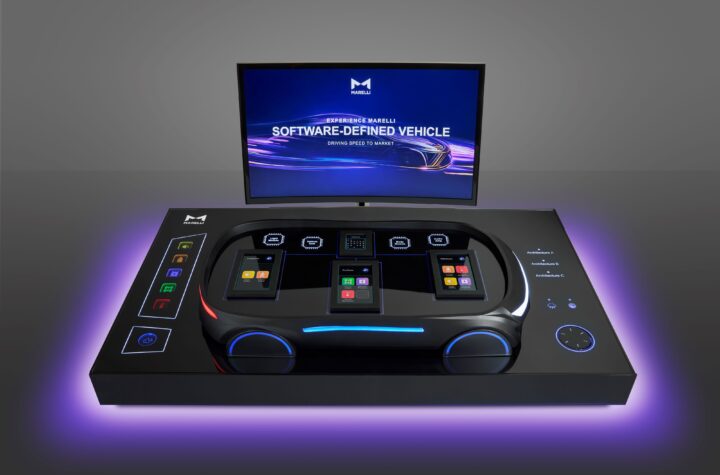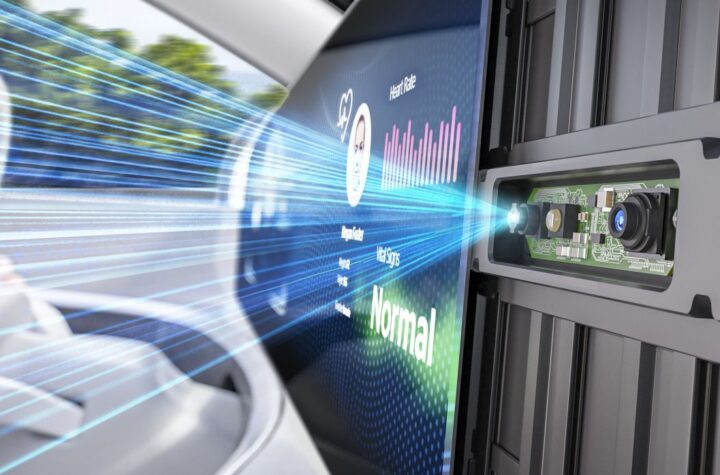

Digital screens have long been a familiar feature of car interiors. First used as multimedia controls and GPS navigation maps, digital screens have evolved into interactive interfaces to control and monitor virtually every function of the automobile.
The digitalization of the car dashboard continues as digital screens enter instrument clusters. A large number of them are hybrid – combining analog gauges with a digital screen. But more and more new models, especially in the premium segment, feature fully digital instrument clusters with unlimited possibilities for presenting information and enhancing the driver’s experience.
Fully digital clusters can show all vital information such as speed, map and navigation prompts, incoming calls, radio stations, system alerts, and more – all without a driver having to look away at a center stack display, minimizing distraction. Many premium automakers, such as Audi and Jaguar Land Rover, have already implemented fully digital instrument clusters in their models.
Now we see the fully digital clusters making their appearance in mid-level vehicles. Questions that arise include: What does it take to implement a fully digital IC in a new car model? How critical is the role of software in successful implementation? Automotive Industries (AI) decided to ask Mikhail Bykov, Managing Director of Luxoft Automotive. Over the last decade, Luxoft has been a leading independent software provider and integrator in the car user experience (UX) and human-machine interface (HMI) space.
AI: What is Luxoft’s role in facilitating a wider adoption of fully digital instrument clusters?
Bykov: With many years of experience in creating automotive UX and HMI for the leading global car manufacturers, Luxoft is in a unique position to help create fully digital instrument clusters that are both user-friendly and aesthetically appealing. We offer a combination of professional development services and the HMI design tool chain Populus, which is Luxoft’s “know-how”. The Populus Suite dramatically cuts the time from an initial brainstorming session to production-ready HMI and ensures a bug-free operation. Add to that a team of our experienced engineers and designers, and you have the ability to create high-quality, robust digital clusters in record time.
AI: Can you tell us more about Populus tool chain?
Bykov: Populus is specifically designed to create software for digital instrument clusters, as well as low- to mid-market head units. Virtually all automakers and suppliers who develop instrument digital clusters can benefit from using the Populus Suite, which is available under license. There is a large number of vehicles manufactured by leading U.S. and European OEMs, which feature HMIs developed using Populus Suite. The suite has been used to produce cluster HMIs for more than seven million vehicles.
Requiring small memory footprint and low processing resources to run, Populus minimizes the time and cost of producing full-featured HMIs and enables efficient software lifecycle management. Populus is very easy to start and run with its intuitive WYSIWYG (what you see is what you get) editor. It doesn’t take heavily trained engineers to create a great-looking HMI using Populus, which further contributes to the overall cost advantage.
AI: How do the instrument cluster requirements vary for entry-level to premium level?
Bykov: When it comes to digital instrument clusters, they all must comply with safety regulations and minimize driver distraction. For the high-end car models, however, it’s also important to create a premium look and feel that is unique to that particular brand. We believe that the leading brands will differentiate themselves by the distinct user experiences they create in their vehicles. Such premium-looking instrument clusters require large amounts of processing power resulting in high bills of materials (BOMs). In fact, the semiconductor chip is a major contributor to the overall cost of the system. In order to make the digital instrument clusters competitive in the low-end market, the software must work with cheaper hardware platforms that have limited resources, both in terms of memory footprint and processing power. Populus-powered digital clusters require very little hardware resources and still look great and deliver high performance, which makes Populus an ideal solution for the low-end market.
AI: What is unique about Luxoft’s solution?
Bykov: The Populus Suite helps achieve high performance using low memory and processing resources, which is unique in the market. It opens up immense possibilities for OEMs which want to differentiate their entry-level models in the market by offering fully digital instrument clusters without sacrificing the cost advantage. At the same time, we offer significant time to market improvement for all types of cars, including high-end models. In the market since 2009, the Populus Suite supports a wide number of platforms, including Linux, QNX, AUTOSAR, iOS, Android and more. The feature modularity of the Populus’ engine offers developers a lot of flexibility.
But the main advantage of working with Luxoft is the knowledge and expertise of its engineers, and the scalability that we can offer, as well as our hybrid onshore/offshore model. At Luxoft, we always try to provide more value to clients. One way of doing so is with our investment into in-house R&D, which is what we have been doing for over five years. This has allowed us to create a state-of-the-art UX creative lab producing award-winning car HMI designs.
AI: How do digital instrument clusters fit into the big picture of car HMI?
Bykov: There will always be multiple screens in a car, and a well-designed HMI should seamlessly combine them – whether in-dash or brought-in – from the digital instrument cluster to smart devices. Smart HMI fuses connectivity, anti-distraction factors, and context adaptation with strict ergonomic requirements. The HMI is situation-aware and continually optimizes driver’s workload. With intelligent HMI, a driver can easily focus on the road without excessive stimulation or distraction and have increased awareness and responsiveness.
In addition to Populus, Luxoft has another tool chain, called Teora, which is perfect for creating premium-looking IVI (in-vehicle infotainment) HMI for head units. Finally, a head-up display (HUD) is another crucial component of the modern HMI. We take a holistic approach to the car HMI and design it in such a way that the different screens work seamlessly together to minimize the driver’s distraction and workload.
AI: Does Populus also work for HUDs?
Bykov: With Populus you can create HMI for head-up displays. HUDs allow drivers to keep eyes on the road and their use will increase as HUDs become more affordable. Computer vision and augmented reality are two key technologies that determine the effectiveness of an HUD. Computer vision is also absolutely crucial for autonomous driving. Luxoft has developed a Computer Vision & Augmented Reality software framework that enables the development of HUDs, autonomous driving, and many other automotive applications using an in-dash display and smart glasses. A hardware-agnostic framework can be quickly adapted to run on virtually any hardware platform, saving significant time and costs.
AI: What is the future of digital instrument clusters?
Bykov: The digital instrument cluster is becoming the main screen in automobiles. Digital clusters enhance the “car-ness” of the driving experience and benefit drivers with the ultimate in flexibility and by offering real-time critical information when needed.
According to one forecast, over seven million cars will have fully digital instrument clusters by 2018. We believe that the actual number will be even higher. The Automotive industry has embraced all things digital. As a result, industry leaders are rethinking strategies and business models. Luxoft provides thought leadership, industry expertise, resource scalability, and prebuilt solutions to help its partners stand out from competition and create a better driving experience for future drivers.











More Stories
Marelli focuses on Software-Defined Vehicle evolution at Auto Shanghai 2025, introducing the new ProZone zone control unit
Will Cars Function Like Smartwatches in the Future?
Marelli to Showcase Latest “Speed-to-Market” Innovations at Auto Shanghai 2025